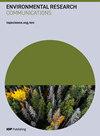Evaluating Non-Consumptive Household Water Uses in a growing Urban centre in Nigeria.
IF 2.5
4区 环境科学与生态学
Q3 ENVIRONMENTAL SCIENCES
引用次数: 0
Abstract
Efficient use of water could be partly achieved with sound management strategies of the non-consumptive uses (N-CUs) of water in homes being put in place. This research evaluated the non-consumptive water use component in Iwo, Osun State, Nigeria. Data required for the investigation was generated from the administration of 325 questionnaires across the five Quarters into which the town is divided, out of which 269 were completed and retrieved. Both descriptive and inferential analysis of the data were carried out. Descriptive analysis showed that households engage absolutely in different non-consumptive uses such as bathing, clothe washing, drainage cleaning and dish washing while households’ engagement in other N-CUs were in varying proportions. The results of Factor Analysis (FA) revealed that five out of the 13 variables identified and analyzed with a minimum eigen value of 1.000 were strong explanatory variables of 73.674% when engaging in issues relating to N-CUs at household level. These are water use for the following (i) drainage cleaning (16.153%); (ii) Dish washing (15.922%); (iii) Toilet cleaning (14.547%); (iv) Auto-wash (14.238%); and Bathing (12.814%). Regression analysis (RA) of the data revealed that three variables namely clothe washing, Incidental washing and auto-washing were significant (p<0.001) in generating predictive model of N-CUs of water in homes. The combined results of FA and RA implied that the set of variables in both analysis need to be considered in any issue involving the management and control of N-CUs of water in homes for a result-oriented water use efficiency at household level.评估尼日利亚一个不断发展的城市中心的非消耗性家庭用水。
通过对家庭非消耗性用水(N-CU)实施合理的管理策略,可以在一定程度上实现高效用水。本研究对尼日利亚奥孙州伊沃市的非消耗性用水情况进行了评估。调查所需的数据来自于对该镇划分的五个区发放的 325 份调查问卷,其中 269 份已完成并收回。对数据进行了描述性和推论性分析。描述性分析表明,住户绝对参与不同的非消耗性用途,如洗澡、洗衣服、清理下水道和洗碗,而住户参与其他非消耗性用途的比例各不相同。因子分析(Factor Analysis,FA)的结果表明,在 13 个被识别和分析的变量中,有 5 个变量的特征值最小值为 1.000,它们对家庭层面的 N-CUs 问题具有 73.674% 的强解释性。这些变量分别是:(i) 清洁下水道(16.153%);(ii) 洗碗(15.922%);(iii) 清洁厕所(14.547%);(iv) 自动清洗(14.238%);以及洗澡(12.814%)。数据回归分析(RA)显示,三个变量,即衣物清洗、偶然清洗和自动清洗,在生成家庭用水 N-CU 预测模型方面具有显著性(P<0.001)。FA和RA的综合结果表明,在任何涉及家庭净用水量管理和控制的问题上,都需要考虑这两项分析中的变量集,以便在家庭层面实现以结果为导向的用水效率。
本文章由计算机程序翻译,如有差异,请以英文原文为准。
求助全文
约1分钟内获得全文
求助全文

 求助内容:
求助内容: 应助结果提醒方式:
应助结果提醒方式:


